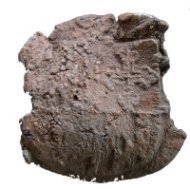Lead Alloy Conservation

Lead alloy is a term used to describe any metal whose primary component is lead. It has been worked into objects for thousands of years and remains one of the most common minerals still mined. Lead is a popular choice for many objects because it is very soft, has a low melting point and is therefore very malleable. Lead has been used for building components, military hardware, personal and domestic items e.g. flatware, drinking vessels and platters. Lead is usually combined with another metal to give it a slightly harder composition and a more crisp appearance. Lead solder is commonly found on lead for repairs, or on windows to form joints between lead window cames. It is typically 40% lead and 60% tin. Lead can be easily identified because it is a very heavy metal, and often much heavier than expected for the size of the object.
Natural lead is blue-grey in color, but when it is exposed to oxygen it turns dull grey. Lead is very susceptible to oxidation, and in such an environment it begins to tarnish almost immediately. Lead is also known to degrade more rapidly in an acidic environment than one that is neutral or basic. During burial, lead rarely survives intact without some damage. Physically, lead objects are often found very misshapen or smashed due to the softness of the metal. Chemical changes also occur with lead – in an aerated environment the surfaces of lead are quickly oxidized and continue to corrode from the exterior inwards. The surfaces are turned a dull brown-grey color and sometimes advanced corrosion appears like white, soft powder on the surfaces. Lead is easily damaged by organic acids so exposure to acids during burial increases this corrosion
|
TYPES OF LEAD ALLOY CORROSION |
|
Lead oxides |
A thin layer of protective corrosion usually close to the original surface; usually brown/dull in appearance
|
|
Lead carbonates |
This type of corrosion forms more slowly in reaction to oxygen and Water; found on lead excavated from aerated-damp sites
|
|
Lead-acetates |
Usually occurs post-excavation from exposure to pollutants (acetic acid by-products) in display cases/ materials or in storage; the corrosion appears as red dots on the surface of the lead
|
Pewter
Lead is commonly alloyed with tin to form pewter. Modern day pewter contains less lead than that of the 17th century and earlier. Pewter was created to increase the strength of lead, as typical pewter is 85% tin/15% lead. Pewter can also contain copper, antimony and zinc. Pewter is commonly used for tablewares, as an imitation of silver in the 17th and 18th centuries. It is also used for cast items such as buttons and candlestick
When pewter is found upon excavation, it is usually more fragile than it appears. During burial the lead is leached from the pewter, leaving behind a thinned matrix of tin with tiny holes throughout where the lead ions once existed. The surfaces are usually dull grey in appearance, with cracks running through the surfaces. Sometimes the pewter will crumble upon touching it. Generally the surface details are visible but there are lead and tin oxide corrosion products found throughout the matrix, causing internal stress and damage. Pewter is very hard to preserve because it is chemically unstable


